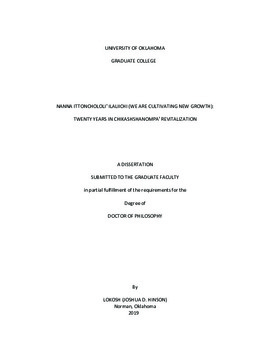| dc.description.abstract | This dissertation is an autoethnographic examination of twenty years in Chikashshanompaꞌ revitalization. Presented in the form of a tanap nannanoliꞌ , this research is presented as a story, told from my individual perspective, composed of two narrative threads. The first is a highly personal account of my language-learning journey since 2000. The second is an account of the Chickasaw Language Revitalization Program’s efforts since 2007 to bring Chikashshanompaꞌ back to prominence among our people, and is filtered through my experience and perspective as the director of that program. Together, these dual narratives offer a case study of Chikashshiyaakniꞌ’s efforts to revitalize our language, and my own efforts to reclaim Chikashshanompaꞌ for myself and my descendants.
As a contemporary Chikashsha person who still carries my clan and house group, I engaged with this research through a Chikashsha asilhlha (Chikashsha research) methodology. The method derives from what Opaskwayak Cree scholar Shawn Wilson termed ‘an Indigenous Research Paradigm.’ In this case, the paradigm is the lived experience of the Chikashsha people, a method that focuses on relationality and the maintenance of right relationships in the process of research. I began with ancestral metaphors conflating Chikashshiyaakniꞌ with an ancient tree, and developed a culturally derived theory of language loss and revitalization, deriving from the word ittonchololiꞌ, meaning ‘new growth from a tree’. In this research I demonstrate how the four values of Chikashsha poya ‘We are Chickasaw’, a theoretical framework deriving from Chikashsha ways of being, are lived out in our revitalization context. Chikashsha poya is composed of four Chikashsha values: identity, survivance through mediation, perseverance through change, and the cultural imperative to remain an intact, dynamic, active tribal nation. By living out the values of Chikashsha poya, we are able to stand and say, in our own language, Chikashsha poꞌyacha iláyya’sha katihma, ‘We are Chikashsha, and we are still here.’
Finally, I explore what I have termed Mediated Language Change (MLC), a theoretically informed method and set of processes by which we control, to varying degrees, language change that comes with any revitalization environment. MLC is simultaneously a theory (languages change, and we can control the changes that occur in the language revitalization process), a method (a mixed-methods approach that attempts to balance the need to equip language learners with linguistically accurate, culturally appropriate language forms through immersion education with the natural need of a language to grow and change through lexical innovation), and a set of processes (including language documentation, analysis, interventional activities, and instruction). MLC is rooted in our obligation to carry the language forward in a way that respects the knowledge of Posipóngniꞌ and encourages expansion and growth of Chikashshanompaꞌ. | en_US |

